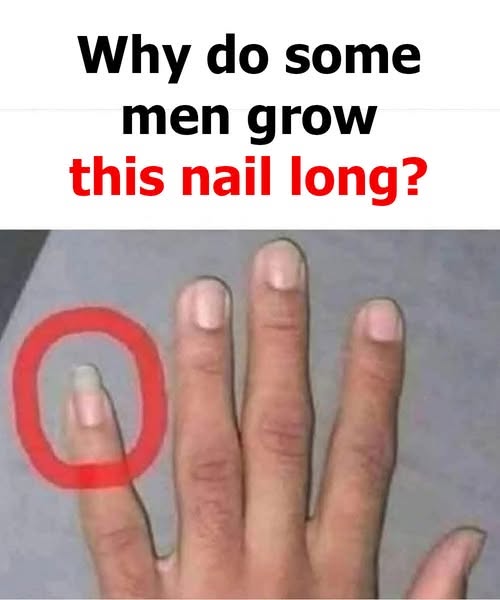Throughout history, even the smallest details of personal appearance have carried surprising meaning. One such detail—the length of a person’s little fingernail—has taken on a variety of interpretations across different cultures and time periods. While it may seem trivial to some, a long pinky nail has served as a subtle yet powerful symbol, shifting in significance from a marker of status and intellect to a tool of practicality and, more recently, a statement of personal identity.

In ancient China, a long pinky nail was much more than a fashion choice. It was a sign of high social standing, a quiet but unmistakable way to communicate that the wearer did not engage in manual labor. Back then, long, delicate nails—especially on the smallest finger—implied that a person’s hands were unaccustomed to hard work. This, in turn, suggested wealth, leisure, and refinement. Those who wore their pinky nails long could afford to dedicate their lives to pursuits that didn’t require physical toil. Even today, remnants of this tradition persist. In certain parts of modern China, you might still see individuals, such as taxi drivers, maintaining a long pinky nail as a personal point of pride or as a small badge of social standing.
Beyond its association with wealth, the long pinky nail also carried intellectual and cultural connotations. In both Chinese and ancient Greek traditions, it was connected to scholarship, learning, and refinement of the mind. To wear such a nail wasn’t just to signal luxury—it was to project an image of being well-read, cultured, and educated. In these contexts, the nail was more than just a decorative flourish; it was a symbol of a cultivated life.
Practicality also played a role in the long pinky nail’s history. In some countries, such as Turkey, people grew out the nail to use it as a small, convenient tool. It could slice open cigarette packs, scratch an itch in a hard-to-reach spot, or help peel the seal off tiny packages. For many, it wasn’t just ornamental—it was functional. This made the pinky nail a unique example of personal grooming that bridged beauty and utility.
As the decades rolled on, the meaning of the long pinky nail continued to evolve. By the 1970s, it had been adopted by certain subcultures for entirely new reasons. In some circles, it became a discreet tool for drug use—long enough to scoop or separate small amounts of powder without attracting much attention. For others, it was purely a matter of style or cultural identity, a small but distinctive flourish that set them apart from mainstream trends. These different interpretations highlighted how the same physical feature could carry vastly different meanings depending on the social group in question.
The long pinky nail also became a fashion statement in its own right, appearing in music scenes, counterculture movements, and among people who simply enjoyed its aesthetic appeal. In these cases, the nail’s symbolism had less to do with social class or function and more to do with self-expression. It was a subtle way to say, “This is who I am,” without uttering a single word.
What’s fascinating is that there is no single, universal meaning behind a long pinky nail. Its significance depends heavily on where and when it appears, as well as on the intentions of the person wearing it. In one culture, it might suggest privilege; in another, intellect; in yet another, it might simply be a tool or a fashion choice. This flexibility is part of what makes it such an enduring and intriguing cultural marker.
The important thing to remember is that symbols, no matter how small, are always shaped by context. A long pinky nail can speak volumes, but exactly what it says depends on the language of culture, time, and personal identity. What one person sees as insignificant, another might see as a proud tradition—or even a statement of rebellion.
From imperial courts in ancient China to bustling city streets in the 20th century, the long pinky nail has proven that even the tiniest physical details can hold a world of meaning. Whether as a marker of high status, a sign of intellect, a handy everyday tool, or a piece of personal style, this small feature has left a surprisingly large mark on human history.





